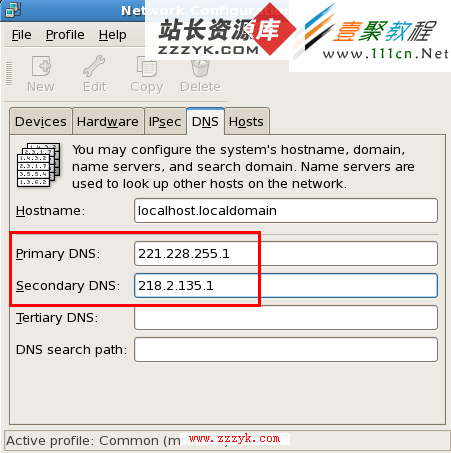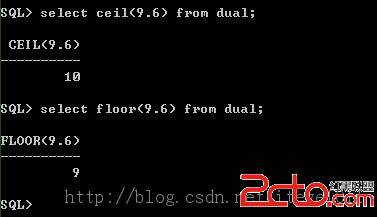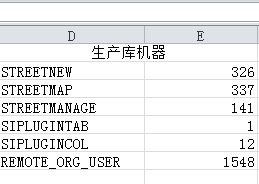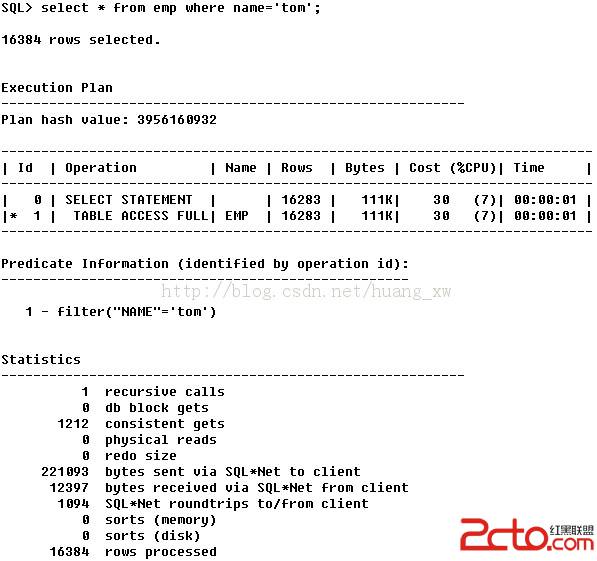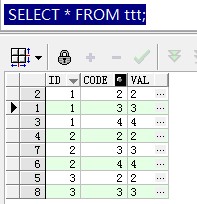当前位置:数据库 > Oracle >>
答案:
1, Uncompress and unpack downloaded files
One step procedure (uses less disk space and is faster):
zcat lnx_920_disk1.cpio.gz | cpio -idmv
zcat lnx_920_disk2.cpio.gz | cpio -idmv
zcat lnx_920_disk3.cpio.gz | cpio -idmv
Two step procedure:
# Uncompress
gunzip lnx_920_disk1.cpio.gz lnx_920_disk2.cpio.gz lnx_920_disk3.cpio.gz Linux9i_Disk3.cpio.gz
# Unpack the downloaded files:
cpio -idmv < lnx_920_disk1.cpio
cpio -idmv < lnx_920_disk2.cpio
cpio -idmv < lnx_920_disk3.cpio
Now you should have 3 directories containing installation files:
Disk1
Disk2
Disk3
2, Swap space
In order to perform a typical Oracle 9i installation and to create a 易做图 prototype database, Oracle says that you need a minimum of 512MB of RAM for the Oracle9i (9.0.1) Server, and the amount of disk space (swap space) should be equal to twice the amount of RAM or at least 400 MB, whichever is greater.
Check your memory by executing:
grep MemTotal /proc/meminfo
Check swap space by executing:
cat /proc/swaps or swapon –s
You can also add temporary swap space by creating a temporary swap file instead of using a raw device. Here is the procedure:
As root:
dd if=/dev/zero of=tmpswap bs=1k count=900000
chmod 600 tmpswap
mkswap tmpswap
swapon tmpswap
To disable the temporary swap space execute the following commands:
As root:
swapoff tmpswap
rm tmpswap
3, Shared Memory
I increased the shmmax setting for the kernel by executing the following command:
As root:
# cat /proc/sys/kernel/shmmax
33554432
# echo `expr 1024 \* 1024 \* 1024` > /proc/sys/kernel/shmmax
It is recommended to increase the shmmax setting permanently for Oracle. So if you want to increase the maximum shared memory size permanently, add the following line to the /etc/sysctl.conf file:
kernel.shmmax=1073741824
4,/tmp Space
The Oracle Universal Installer requires up to 400 MB of free space in the /tmp directory. If you do not have enough space in the /tmp directory, you can temporarily create a tmp directory in another filesystem. Here is how you can do this:
As root:
mkdir /<AnotherFilesystem>/tmp
chown root.root /<AnotherFilesystem>/tmp
chmod 1777 /<AnotherFilesystem>/tmp
export TEMP=/<AnotherFilesystem>/tmp # used by Oracle
export TMPDIR=/<AnotherFilesystem>/tmp # used by Linux programs like the linker "ld"
When you are done with your Oracle installation, shutdown Oracle and remove the temporary directory:
rmdir /<AnotherFilesystem>/tmp
unset TEMP
unset TMPDIR
5,Oracle Disk Space
You will need about 2.5 GB for the database software. If you perform a typical database installation and not a customized database installation, then you will need about 3.5 GB of disk space.
6,"binutils" Issue (if you fond following error )
Q: "Error invoking target install of makefile /opt/oracle/product/9.0.1/plsql/lib/ins_plsql.mk"
A: This obviates the need to change binutils
download the following binutil RPM version and downgrade binutil on the Oracle server:
ftp://ftp.redhat.com/pub/redhat/linux/7.0/en/os/i386/RedHat/RPMS/binutils-2.10.0.18-1.i386.rpm
As root:
rpm -Uvh --force --nodeps binutils-2.10.0.18-1.i386.rpm
When you are done with the Oracle installation, you upgrade your binutil RPM back to the version you had before you downgraded:
E.g. on a Red Hat 7.2 server:
rpm -Uvh --force --nodeps binutils-2.11.90.0.8-9.i386.rpm
7,Development Packages (RPMs)
You will need the following RPM development packages for the Oracle installer to compile the Oracle modules etc.:
gcc
cpp
glibc-devel
compat-libstdc++
kernel-headers (on RH 7.1, 7.2, 2.1AS)
glibc-kernheaders (on RH 7.3, 8.0)
binutils
Otherwise you'll get an error message like:
Error in invoking target ntcontab.o of makefile /opt/oracle/product/9.2.0/network/lib/ins_net_client.mk
To find out if you have these development packages installed, execute the following command:
# rpm -q gcc cpp glibc-devel kernel-headers binutils
8,JDK
I successfully installed Oracle9iR2 without installing JDK on the system.Oracle comes now with its own Java. This means that you don't have to follow these steps which were required for older Oracle versions:
Download JDK 1.3.1 or Blackdown 1.1.8_v3: (I usually used Blackdown)
http://www.blackdown.org
http://java.sun.com
According to JDK documentation, install JDK under /usr/local .
Then create a symbolic link to the JDK under /usr/local/java :
As root:
bzip2 -dc jdk118_v3-glibc-2.1.3.tar.bz2 | tar xf - -C /usr/local
ln -s /usr/local/jdk118_v3 /usr/local/java
9,Create Oracle User Accounts
As root:
groupadd dba
groupadd oinstall
useradd -g oinstall -G dba oracle
passwd oracle
Oinstall is not needed when the same people will be maintaining the software and the database. In this situation, it will create more work and add an extra layer of complexity to the maintenance of the installation.
Recommendation: if you don't need the oinstall group for added security,
just install using the dba group.
10,Create Oracle Directories
In this example, make sure that the /opt filesystem is large enough. If /opt is not on a separate filesystem, then make sure the root filesystem "/" has enough space.
As root:
mkdir /opt/oracle
mkdir /opt/oracle/product
mkdir /opt/oracle/product/9.2.0
chown -R oracle.oinstall /opt/oracle
mkdir /var/opt/oracle
chown oracle.dba /var/opt/oracle
chmod 755 /var/opt/oracle
11,Set Oracle Environments
Set the following Oracle environment variables before you start runInstaller.
As the oracle user execute the following commands:
# Oracle Environment
export ORACLE_BASE=/opt/oracle
export ORACLE_HOME=/opt/oracle/product/9.2.0
export ORACLE_SID=test
export ORACLE_TERM=xterm
#export TNS_ADMIN= Set if sqlnet.ora, tnsnames.ora, etc. are not in $ORACLE_HOME/network/admin
export NLS_LANG=AMERICAN #export NLS_LANG=AMERICAN_AMERICA.ZHS16GBK;(if you use Chinese)
export ORA_NLS33=$ORACLE_HOME/ocommon/nls/admin/data
LD_LIBRARY_PATH=$ORACLE_HOME/lib:/lib:/usr/lib
LD_LIBRARY_PATH=$LD_LIBRARY_PATH:/usr/local/lib
export LD_LIBRARY_PATH
# Set shell search paths
export PATH=$PATH:$ORACLE_HOME/bin
# I successfully installed Oracle9iR2 WITHOUT setting the following CLASSPATH environment variable:
CLASSPATH=$ORACLE_HOME/JRE:$ORACLE_HOME/jlib:$ORACLE_HOME/rdbms/jlib
CLASSPATH=$CLASSPATH:$ORACLE_HOME/network/jlib
export CLASSPATH
export TMPDIR=/tmp
You can put these environment settings at the end of the ~oracle/.bash_profile file if you use bash.
12,Start runInstaller
Oracle no longer supports a character mode installer. Therefore, in order to execute runInstaller directly from a console of a machine you are logged into (in this example the node name where Oracle is running is called "oracleserver"), you need to set the DISPLAY environment variable.
From the console of your Oracle server "oracleserver " you are logged into, execute the following command as user " orac
- 更多Oracle疑问解答:
- 运行exp备份oracle数据库提示oracle-12154错误
- 有没有,生产Oracle Rman 备份脚本的工具啊!
- 初学orcle,希望有大大帮忙解说一下详细步骤,从登录oracle到创建表的过程
- oracle语句问题:一张user表,三个字段,id,name,time,插入记录比如:张三2007,李四2008,张三2011
- 如何写一个ORACLE触发器同步两个表中的数据?
- oracle 如何查看一个服务器上有多少个数据库.
- oracle 创建包的时候错误 求解
- oracle 重复列的问题
- oracle 中如何查处2星期前的数据
- 请教oracle数据库安装中的问题
- 请问谁能提供给我标准的oracle ERP的数据库表结构并详细说明各表主要的作用?
- 安装oracle遇到的问题 invalid entry CRC (expected 0x3e12e795 but got 0x9db0e9fd)
- 我的是ORACLE 10G,在RMAN中如何按指定的时间恢复数据文件啊?
- oracle为什么没有自动增长列
- oracle快捷键都有哪些啊?
